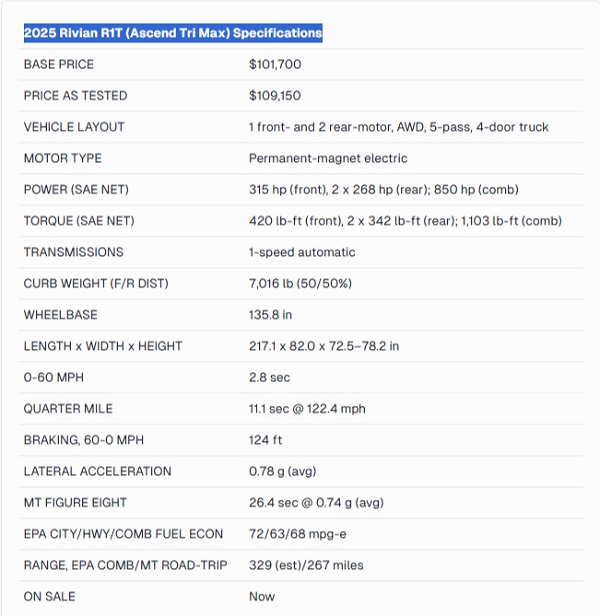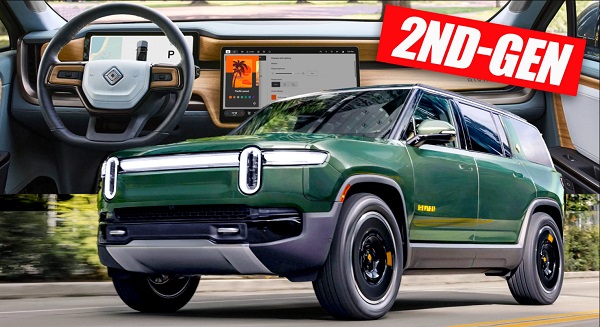Rivian’s second-generation R1T encourages you to invest an additional $20,000 over its dual-motor electric truck, revealing that it may not be the fastest, most efficient, or most capable model in the lineup.
Can You Identify the Changes in the Second Generation?
Some visual modifications that distinguish the 2025 R1T from the prior model might go unnoticed, including a reduced frunk, alterations in the lighting, revamped door handles, and enhancements to the audio system. Even subtler is the shift towards zonal architecture, a design approach that minimizes the number of ECUs, thereby cutting costs, complexity, and weight. Each R1T is 44 pounds lighter than its predecessor, featuring 10 fewer ECUs (now just seven, each ten times more powerful) and 1.6 miles less wiring.
The R1T Tri is equipped with a single drive motor at the front and the same dual-motor setup at the rear as the quad-motor R1T. All motors produced by Rivian are now oil-cooled, which improves heat management during low-speed off-roading and enhances efficiency on highways. Furthermore, both front and rear motors are manufactured in-house on the same production line.
An Electric Sports Truck?
The launch mode, now available on the tri- and quad-motor R1Ts, requires a moment to engage as the truck lowers and prepares the battery. “Acceleration of this magnitude is genuinely in the realm of ‘takes your breath away,’ and it can take a moment to extract yourself from the seat post-launch,” noted our test driver. Our team observed some slight shaking of the steering wheel at high speeds, though the overall sensation was quite stable. With 850 horsepower, the Tri accelerates to 60 mph in 2.8 seconds, outperforming the Dual’s 3.4 seconds, but it isn’t the fastest time for any Rivian truck, as the new Quad reached 2.5 seconds—the fastest we’ve ever recorded.
If you hit the brakes on the R1T Tri, you’ll need 124 feet to stop the 7,016-pound vehicle. The R1T Quad can accomplish this in 104 feet but uses performance summer tires compared to the Tri’s rugged all-terrain options. The dual-motor R1T took 120 feet to come to a stop. Except during emergency braking, we found the brake pedal’s travel to be a bit long but manageable while navigating turns. Just keep in mind that this heavy truck will understeer significantly if you miscalculate the braking area. However, if you hit the brakes firmly, you can clearly feel the power predominantly directed toward the rear as you exit a turn, regardless of the drive mode.

Off-Road Challenges
By upgrading to the R1T Tri, you gain access to drive modes like Rock Crawl, Drift, and Rally, similar to the Quad. The dual-motor R1T is restricted to All Purpose, All-Terrain, Snow, Sport, and Soft Sand modes. We tested the Pirelli Scorpion All Terrain Plus tires in off-road conditions and were impressed by how the 20-inch wheels and sturdy tires (part of the $3,950 All Terrain package) absorbed the bumps on rough trails. Each of the Tri’s off-road modes is also specifically calibrated for different trail situations—whether it’s drifting in the open desert or skillfully navigating through boulders. Our R1T Tri experienced overheating in its two rear motors during a steep rock climbing challenge in Rock Crawl mode, resulting in an unexpected power cut and a safe backward roll. A brief cool down and a power reset seemed to fix the problem, but we didn’t attempt any more rock climbing that day. Overall, we found the R1T Tri competent on trails, but the suspension felt somewhat loose and unrefined when traversing lightly bumpy dirt paths.
What’s the R1T Tri’s Range?
We were generally excited to jump into the tri-motor R1T, select Conserve mode, and see the range display exceed 400 miles after a full charge. In our MotorTrend Road-Trip Range test, we achieved 267 miles from the 140-kWh Max battery pack. To do so, we maintained a steady speed of 70 mph on a relatively flat route in All Purpose drive mode, unladen, with just the driver in the vehicle. In similar conditions, the Rivian R1T Quad depleted nearly all but 5 percent of its battery 24 miles sooner than the tri-motor, while the Dual-Motor version lasted for 340 miles during our test, running for almost another hour before needing to recharge. The Tri’s Road-Trip Range sits comfortably between the Tesla Cybertruck Beast (229 miles) and the dual-motor models (295 miles).
Verdict: What is the Purpose of This Truck?
If the R1T Tri isn’t the fastest, most efficient, or most capable variant, what makes it worth your consideration? Well, it’s the most affordable option for accessing those Rock Crawl, Drift, and Rally driving modes. You also get the distinctive driving characteristics of the tri-motor configuration. Plus, yellow brake calipers. The Quad is quicker and more powerful because it has a motor on each wheel to distribute torque more effectively on challenging terrain, and it starts at roughly $10K more (featuring teal calipers). The Dual Max, while a less expensive choice with around 50 extra miles of range, comes with standard silver calipers.
After testing the R1T Tri on trails, extended-range highways, and the racetrack, we’re uncertain if the Tri presents a compelling case for purchase compared to its counterparts, but there’s no denying that it’s a competent, comfortable, and luxurious electric truck.
By this point, the novelty of incredible EV acceleration has diminished. I mean, which EV doesn’t reach 60 mph in under 3.0 seconds? (Okay, many. But the overall point remains.) That said, I admit a pickup truck that can achieve a 2.5-second dash still merits a couple of respectful nods. However, if sheer electric speed is becoming less remarkable, it’s fortunate that Rivian’s flagship R1T pickup, the Quad Max, encompasses much more than just speed.
This truck focuses more on exploring the spaces in between. Like all R1Ts since the electric pickup’s introduction in 2021, this is an adventure-focused vehicle meant to take you far beyond the limits of civilization while still making sure you enjoy your time stuck in the urban grind.
The 2025 Rivian R1T Quad Max Includes Everything
Certainly, the 2025 Rivian R1T Quad Max ensures you want for nothing in terms of R1Ts, as it comes almost entirely equipped from the start. All versions are fitted with features such as the standard removable flashlight; the secure gear tunnel for wet or muddy gear; ample power outlets; an innovative rooftop and bedside attachment system; and numerous onboard power points. (The previously standard camp speaker/lantern is now a $450 optional accessory.) However, the R1T Quad Max includes a four-motor all-wheel drive system, now crafted by Rivian, allowing for precise torque distribution on trails while enhancing traction on slick surfaces.
It also comes with an onboard air compressor (now only a standard feature on the Tri and Quad), additional on- and off-road driving modes, along with 1,025 horsepower and 1,198 lb-ft of torque. Other than the significantly greater output, most of what’s included has been carried over from the first-generation R1T, whose Quad Motor variant produced “only” 835 hp and 908 lb-ft. The exterior design remains largely unchanged, aside from some new interior and exterior details; the main ways to identify the new R1T Quad Max from other R1T models are the small cartoon Yeti badge on the tailgate and the teal color used for the badging and brake calipers.
In reality, a majority of the approximately 600 changes and enhancements made to the R1 lineup occurred beneath the surface. The electrical system has been simplified to less than half the number of processors and has 1.6 miles less wiring internally. This, along with other upgrades and enhancements, has reduced the R1T’s weight by between 250 and 300 pounds. The combination of weight reduction and power increase allowed the Quad Max to shave off 0.6 seconds from its 0–60 time, enabling it to tie with the Tesla Cybertruck Beast as the fastest pickup truck we’ve ever tested, achieving a time of 2.5 seconds. (If we look closely, the Rivian takes the title at 2.50 seconds compared to 2.54 for the Cybertruck.)
Conquer the Terrain
Unfortunately, it appears Rivian has not fully addressed what the weight reduction means for the ride quality of the second-generation R1T. Driving it without a load or trailer, and independently from other trucks, it feels adequately firm but still okay, while its handling is remarkably impressive. It’s an agile, capable vehicle that offers comfort and confidence both on smooth roads and rugged trails. Moreover, every driving mode can be customized in terms of brake-energy regeneration, ride height, and additional settings, allowing your R1T to be tailored to your preferences in any scenario.
Nearly every other electric pickup truck (not to mention traditional internal combustion engine trucks) handles frost heaves more smoothly, and none makes the kind of creaking and groaning noises from the suspension that you sometimes hear in the R1T. When loaded with weight in the back, this truck begins to sway and bounce. While this may not be an issue for everyday driving, it can cause problems when you’re carrying gear for off-grid excursions. Competitors like the GMC Hummer EV pickup and Cybertruck provide much better ride quality.
“Max” indicates that this Rivian R1T Quad is equipped with the largest battery pack available, roughly 140 kWh, which theoretically provides a range of 360 miles. However, the Max didn’t quite meet expectations, yielding only 243 miles during the 70-mph MotorTrend Road-Trip Range test, which is a 31 percent shortfall from its stated range. This performance falls significantly behind the efficiency displayed by the GMC Sierra EV, which achieved 422 miles in our road-trip testing (only a 4 percent deviation from its advertised range), even though the Sierra uses only two motors. In comparison, a tri-motor Tesla Cybertruck managed 229 miles, 24 percent below its EPA rating. On a positive note, the Rivian can recharge at a relatively competitive rate of 220 kW; we took 53 minutes to charge from 5 to 80 percent. However, plan to double that time to reach a full charge.
You can certainly enjoy the charge time while seated in one of the most stunning interiors found in any vehicle. The use of high-quality materials is evident, with remarkable wood details on the dashboard, doors, and seats. The new Ascend interior theme features beautiful plaid accents on both the seats and floormats, adding a touch of style to the pickup truck. The modernized infotainment system is also impressive; it is easy to navigate, aesthetically appealing, and quicker than before due to the updated electrical architecture.
We especially appreciate the new cel-shaded images that accompany the different drive modes. There’s a generous amount of storage throughout, including options in the gear tunnel, the frunk, the in-bed trunk, the center console, and beneath the rear seats. Our only minor grievance is the air vent adjustments, which are still managed via a screen—this time-consuming approach is not something anyone requested.

Much of the 2025 Rivian R1T Quad Max’s strengths (along with its less-than-ideal ride quality) can also be found in the Tri- or Dual-Motor variants, making the key consideration when choosing a Rivian this: How much are you willing to pay for greater distance or speed? In the instance of our R1T Quad Max test model, that cost is around $110,000, slightly more than the triple-motor vehicles (the maximum they provide) from GMC/Hummer and Tesla.
Nonetheless, neither of those trucks matches the range of capabilities offered by the Rivian nor have interiors as nice. When pushed hard in the sportiest mode, the R1T convincingly mimics a supercar. Venture off-road, and it expertly navigates nearly any obstacle you attempt. Pull into a valet stand at a fine-dining restaurant, and it might just get parked out front. Once inside, it feels worth every cent. The second-generation Rivian R1T remains an extraordinarily impressive electric pickup truck.
While the initial thrill—at least regarding EV acceleration times—might have diminished, assuming Rivian can enhance its ride quality, the new 2025 R1T Quad Max shows that the excitement of the R1T has not faded.


